AWS : ML (Machine Learning)
The AWS Management Console provides a web-based interface for creating, accessing, and managing all Amazon Machine Learning entities.
The Console also includes a walk-through tutorial that guides us through the process of building a machine learning model.
Programmatic access to Amazon Machine Learning is enabled by the AWS SDKs and the AWS Mobile SDK.
We can also create and manage Amazon Machine Learning entities using the AWS Command Line Interface (CLI) available on Windows, Mac, and Linux/UNIX systems.
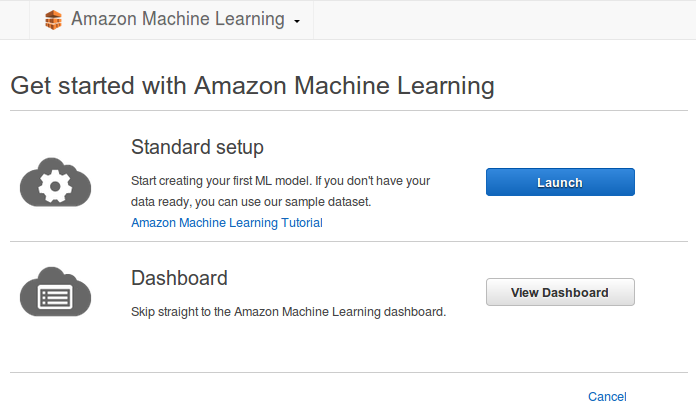
Click Launch.
Type in bogo-devops/banking.csv for S3 location.
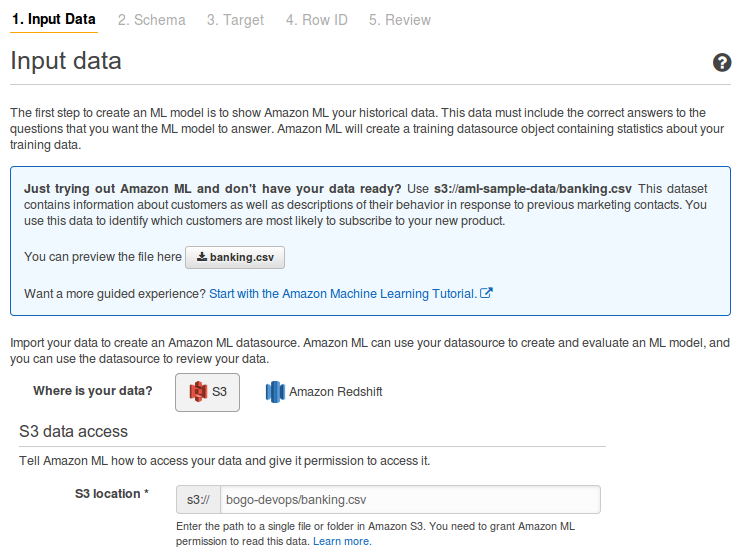
Click "Verify":
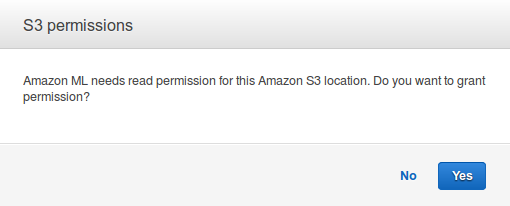
In the S3 permissions dialog box, choose Yes.
If Amazon ML can access and read the data file at the S3 location, we will see a page similar to the following.
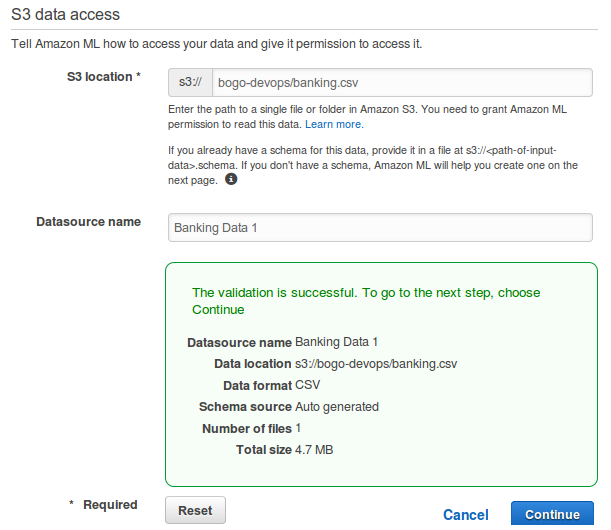
Review the properties, and then choose Continue.
After we upload the banking.csv dataset to Amazon Simple Storage Service (Amazon S3) location, we will use it to create a training datasource.
A datasource is an Amazon Machine Learning (Amazon ML) object that contains the location of our input data and important metadata about our input data. Amazon ML uses the datasource for operations like ML model training and evaluation.
Next, we need to establish a schema.
A schema is the information Amazon ML needs to interpret the input data for an ML model, including attribute names and their assigned data types, and the names of special attributes.
In this tutorial, we'll ask Amazon ML to infer the attribute types and create a schema for us.
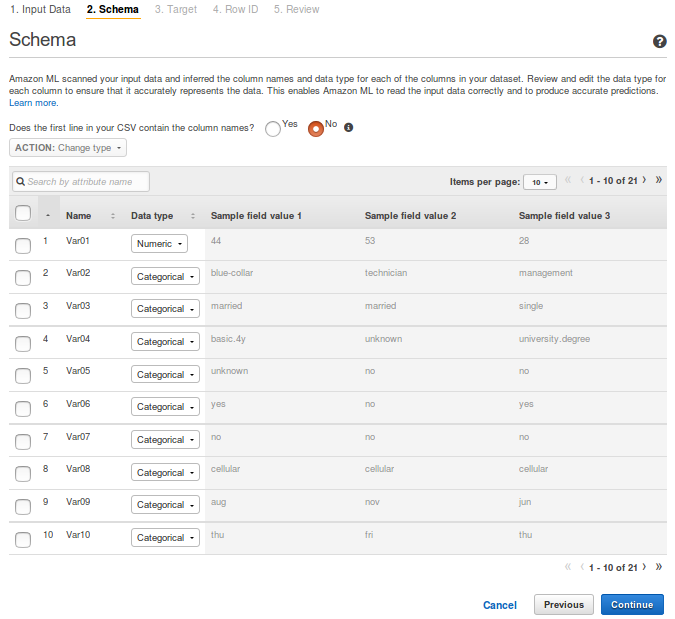
Amazon ML has correctly identified the data types for all of the attributes, so choose Continue.
Next, select a target attribute.
The target is the attribute that the ML model must learn to predict.
Attribute y indicates whether an individual has subscribed to a campaign in the past: 1 (yes) or 0 (no).
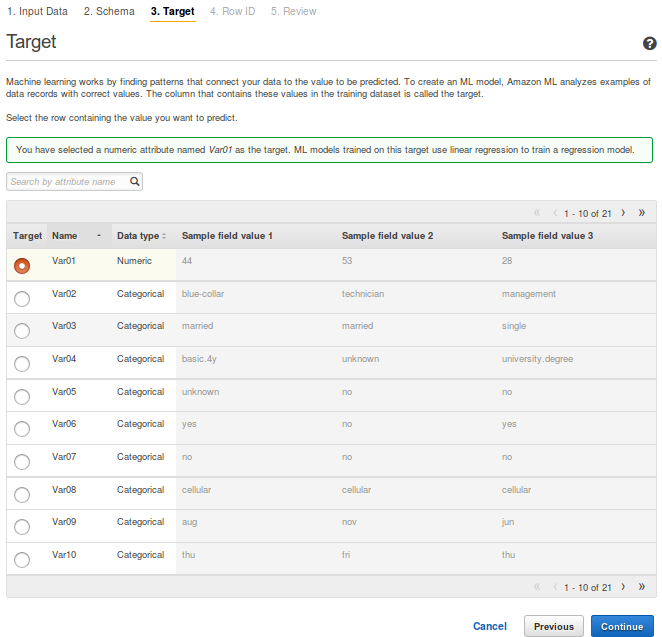
On the Row ID page, for Does your data contain an identifier? , make sure that No, the default, is selected.

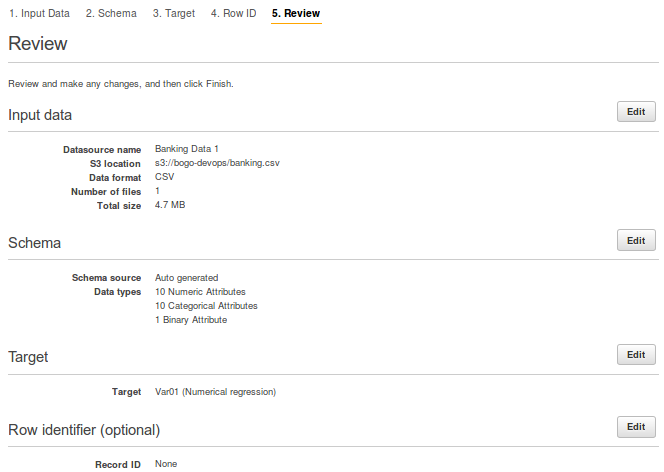
Choose Continue.
Now that we've created the training datasource, we can use it to create an ML model, train the model, and then evaluate the results.
The ML model is a collection of patterns that Amazon ML finds in our data during training.
We use the model to create predictions.
Because the Get started wizard creates both a training datasource and a model, Amazon Machine Learning (Amazon ML) automatically uses the training datasource that weust created, and takes us directly to the ML model settings page.
On the ML model settings page, for ML model name, make sure that the default, ML model: Banking Data 1, is displayed.
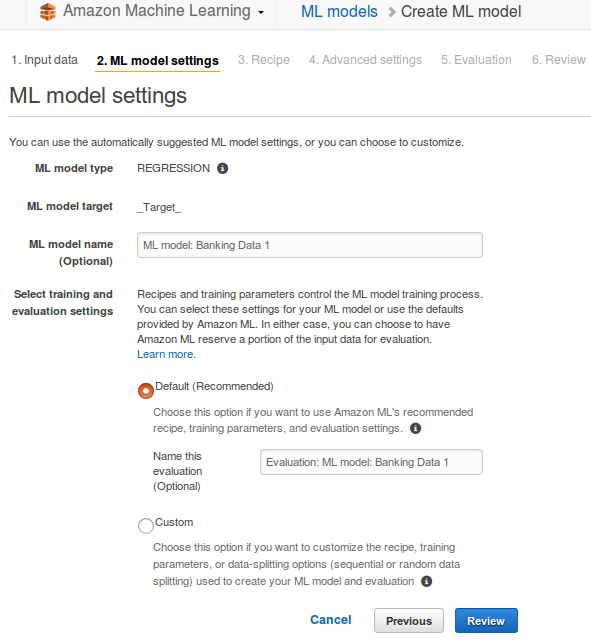
Choose Review, review the settings, and then choose Finish.
After we choose Finish, Amazon ML adds our model to the processing queue.
When Amazon ML creates our model, it applies the defaults and performs the following actions:
- Splits the training datasource into two sections, one containing 70% of the data and one containing the remaining 30%.
- Trains the ML model on the section that contains 70% of the input data.
- Evaluates the model using the remaining 30% of the input data.
Now we are ready to review our models performance and set a cut-off score.
Ref : Review the ML Model's Predictive Performance and Set a Score Threshold.
Now that we've created our ML model and Amazon Machine Learning (Amazon ML) has evaluated it, let's see if it is good enough to put to use.
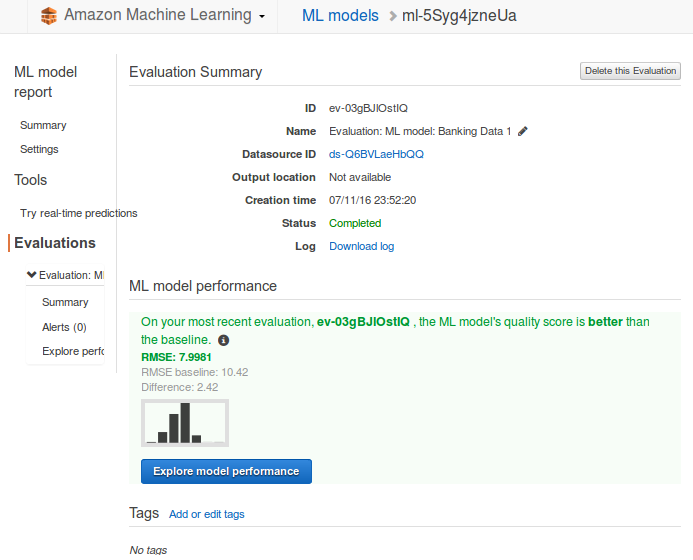
Choose Explore model performance:
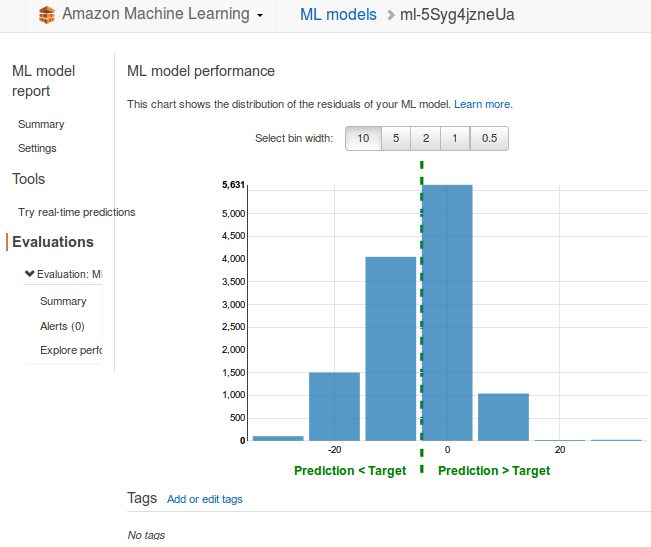
AWS (Amazon Web Services)
- AWS : EKS (Elastic Container Service for Kubernetes)
- AWS : Creating a snapshot (cloning an image)
- AWS : Attaching Amazon EBS volume to an instance
- AWS : Adding swap space to an attached volume via mkswap and swapon
- AWS : Creating an EC2 instance and attaching Amazon EBS volume to the instance using Python boto module with User data
- AWS : Creating an instance to a new region by copying an AMI
- AWS : S3 (Simple Storage Service) 1
- AWS : S3 (Simple Storage Service) 2 - Creating and Deleting a Bucket
- AWS : S3 (Simple Storage Service) 3 - Bucket Versioning
- AWS : S3 (Simple Storage Service) 4 - Uploading a large file
- AWS : S3 (Simple Storage Service) 5 - Uploading folders/files recursively
- AWS : S3 (Simple Storage Service) 6 - Bucket Policy for File/Folder View/Download
- AWS : S3 (Simple Storage Service) 7 - How to Copy or Move Objects from one region to another
- AWS : S3 (Simple Storage Service) 8 - Archiving S3 Data to Glacier
- AWS : Creating a CloudFront distribution with an Amazon S3 origin
- AWS : Creating VPC with CloudFormation
- AWS : WAF (Web Application Firewall) with preconfigured CloudFormation template and Web ACL for CloudFront distribution
- AWS : CloudWatch & Logs with Lambda Function / S3
- AWS : Lambda Serverless Computing with EC2, CloudWatch Alarm, SNS
- AWS : Lambda and SNS - cross account
- AWS : CLI (Command Line Interface)
- AWS : CLI (ECS with ALB & autoscaling)
- AWS : ECS with cloudformation and json task definition
- AWS Application Load Balancer (ALB) and ECS with Flask app
- AWS : Load Balancing with HAProxy (High Availability Proxy)
- AWS : VirtualBox on EC2
- AWS : NTP setup on EC2
- AWS: jq with AWS
- AWS & OpenSSL : Creating / Installing a Server SSL Certificate
- AWS : OpenVPN Access Server 2 Install
- AWS : VPC (Virtual Private Cloud) 1 - netmask, subnets, default gateway, and CIDR
- AWS : VPC (Virtual Private Cloud) 2 - VPC Wizard
- AWS : VPC (Virtual Private Cloud) 3 - VPC Wizard with NAT
- DevOps / Sys Admin Q & A (VI) - AWS VPC setup (public/private subnets with NAT)
- AWS - OpenVPN Protocols : PPTP, L2TP/IPsec, and OpenVPN
- AWS : Autoscaling group (ASG)
- AWS : Setting up Autoscaling Alarms and Notifications via CLI and Cloudformation
- AWS : Adding a SSH User Account on Linux Instance
- AWS : Windows Servers - Remote Desktop Connections using RDP
- AWS : Scheduled stopping and starting an instance - python & cron
- AWS : Detecting stopped instance and sending an alert email using Mandrill smtp
- AWS : Elastic Beanstalk with NodeJS
- AWS : Elastic Beanstalk Inplace/Rolling Blue/Green Deploy
- AWS : Identity and Access Management (IAM) Roles for Amazon EC2
- AWS : Identity and Access Management (IAM) Policies, sts AssumeRole, and delegate access across AWS accounts
- AWS : Identity and Access Management (IAM) sts assume role via aws cli2
- AWS : Creating IAM Roles and associating them with EC2 Instances in CloudFormation
- AWS Identity and Access Management (IAM) Roles, SSO(Single Sign On), SAML(Security Assertion Markup Language), IdP(identity provider), STS(Security Token Service), and ADFS(Active Directory Federation Services)
- AWS : Amazon Route 53
- AWS : Amazon Route 53 - DNS (Domain Name Server) setup
- AWS : Amazon Route 53 - subdomain setup and virtual host on Nginx
- AWS Amazon Route 53 : Private Hosted Zone
- AWS : SNS (Simple Notification Service) example with ELB and CloudWatch
- AWS : Lambda with AWS CloudTrail
- AWS : SQS (Simple Queue Service) with NodeJS and AWS SDK
- AWS : Redshift data warehouse
- AWS : CloudFormation
- AWS : CloudFormation Bootstrap UserData/Metadata
- AWS : CloudFormation - Creating an ASG with rolling update
- AWS : Cloudformation Cross-stack reference
- AWS : OpsWorks
- AWS : Network Load Balancer (NLB) with Autoscaling group (ASG)
- AWS CodeDeploy : Deploy an Application from GitHub
- AWS EC2 Container Service (ECS)
- AWS EC2 Container Service (ECS) II
- AWS Hello World Lambda Function
- AWS Lambda Function Q & A
- AWS Node.js Lambda Function & API Gateway
- AWS API Gateway endpoint invoking Lambda function
- AWS API Gateway invoking Lambda function with Terraform
- AWS API Gateway invoking Lambda function with Terraform - Lambda Container
- Amazon Kinesis Streams
- AWS: Kinesis Data Firehose with Lambda and ElasticSearch
- Amazon DynamoDB
- Amazon DynamoDB with Lambda and CloudWatch
- Loading DynamoDB stream to AWS Elasticsearch service with Lambda
- Amazon ML (Machine Learning)
- Simple Systems Manager (SSM)
- AWS : RDS Connecting to a DB Instance Running the SQL Server Database Engine
- AWS : RDS Importing and Exporting SQL Server Data
- AWS : RDS PostgreSQL & pgAdmin III
- AWS : RDS PostgreSQL 2 - Creating/Deleting a Table
- AWS : MySQL Replication : Master-slave
- AWS : MySQL backup & restore
- AWS RDS : Cross-Region Read Replicas for MySQL and Snapshots for PostgreSQL
- AWS : Restoring Postgres on EC2 instance from S3 backup
- AWS : Q & A
- AWS : Security
- AWS : Security groups vs. network ACLs
- AWS : Scaling-Up
- AWS : Networking
- AWS : Single Sign-on (SSO) with Okta
- AWS : JIT (Just-in-Time) with Okta
Ph.D. / Golden Gate Ave, San Francisco / Seoul National Univ / Carnegie Mellon / UC Berkeley / DevOps / Deep Learning / Visualization